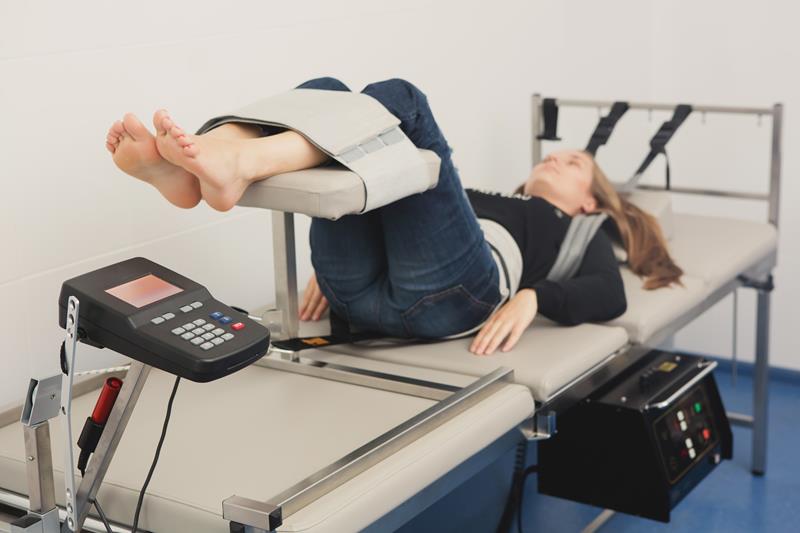
Back on Track Chiropractic is committed to providing innovative care in spinal health. Our spinal decompression therapy is a cornerstone treatment, offering a non-surgical solution to severe and chronic spinal pain that affects overall quality of life.
Why Choose Spinal Decompression?
Spinal decompression therapy is designed for patients who suffer from debilitating pain due to disc herniation, sciatica, and other degenerative spinal disorders. It is a preferred alternative for those seeking effective treatment without the risks associated with surgery.
Proven Benefits of Spinal Decompression
- Direct Pain Relief: Decompression alleviates pressure on pinched nerves, significantly reducing pain and discomfort.
- Long-Term Healing: Promotes the retraction of herniated discs and initiates biological healing processes at the cellular level.
- Non-Invasive Approach: Avoids the need for surgical intervention and the associated recovery times and risks.
In-Depth Look at How Spinal Decompression Works
Advanced Technology
Our clinic utilizes state-of-the-art decompression tables that are programmed to deliver precise stretching of the spine, tailored to each patient’s specific condition. These machines use controlled forces to gently pull apart the vertebrae, creating negative pressures within the disc, which facilitates healing.
Customized Treatment Plans
Each patient’s treatment plan is uniquely designed based on their specific medical history, pain levels, and diagnostic results. Treatment sessions are carefully monitored and adjusted to optimize results.
Comprehensive Care for Various Conditions
Spinal decompression therapy can be particularly effective for:
- Chronic Lower Back Pain: Reduces chronic pain by alleviating pressure on spinal discs and nerves.
- Chronic Neck Pain: Reduces symptoms that range from radiating arm pain to neck pain.
- Sciatica: Targets the root cause of sciatic pain by relieving the pressure on sciatic nerve roots.
- Degenerative Disc Disease: Slows disc degeneration and promotes disc hydration and nutrient uptake.
- Post-Surgical Patients: Offers a post-surgical solution to help manage pain and accelerate recovery without additional surgery.
What to Expect During Your Treatment Journey
Your First Visit
Expect a thorough evaluation during your initial consultation, including imaging studies if recent ones are not available. Our team will discuss your symptoms, treatment expectations, and explain how spinal decompression can be integrated into your overall care plan.
During Therapy Sessions
You will be comfortably positioned on the decompression table with safety straps gently fitted around your body. As the table operates, you may feel a gradual lengthening in your spine, but the process is gentle and not painful.
Follow-Up Care
Aftercare is crucial for achieving the best outcomes. We may recommend supplementary therapies such as physical therapy, exercises, or lifestyle modifications to improve strength and flexibility and prevent future issues.
Begin Your Path to Recovery
Don’t let chronic back pain control your life. Discover how spinal decompression at Back on Track Chiropractic can return you to a life of health and activity. Contact us today at (480) 963-0504 or schedule your appointment online. Let us help you take the first step towards a pain-free life.
Frequently Asked Questions About Spinal Decompression
What is spinal decompression therapy?
Spinal decompression therapy is a non-surgical treatment designed to alleviate pressure on the spinal discs and nerves. It involves the use of a traction table or similar motorized device that gently stretches the spine to promote the movement of water, oxygen, and nutrient-rich fluids into the discs to foster healing.
How does spinal decompression therapy work?
The therapy uses controlled force to gently stretch the spine, creating negative pressures within the disc. This negative pressure pulls the herniated or bulging disc material back into the disc, which helps relieve pressure on the nerves and other structures in your spine. This process also promotes the movement of nutrient-rich fluids into the discs to aid healing.
What are the benefits of spinal decompression therapy?
Key benefits include:
- Pain Relief: Especially effective for back pain, neck pain, and sciatica caused by herniated or bulging discs.
- Reduced Nerve Pressure: Helps decompress spinal nerves that may be pinched by misaligned discs.
- Enhanced Healing: Accelerates the healing process of damaged discs and reduces the likelihood of future back problems.
What conditions can spinal decompression therapy treat?
Spinal decompression therapy is often used to treat:
- Herniated or Bulging Discs
- Degenerative Disc Disease
- Sciatica
- Posterior Facet Syndrome
- Arm pain due to pinched nerves or pinched cervical discs
Is spinal decompression therapy painful?
No, the therapy is not painful. Most patients experience a sense of stretch in their spine, but it should not cause pain. Many find the treatment relaxing and may even fall asleep during the session.
Who is a good candidate for spinal decompression therapy?
Individuals suffering from chronic back pain, sciatica, herniated discs, or those looking for an alternative to surgery may benefit from spinal decompression. A detailed evaluation will help determine if this therapy is suitable for your specific condition.
Are there any risks associated with spinal decompression therapy?
Spinal decompression therapy is generally safe when performed by a qualified healthcare provider. However, it may not be suitable for everyone, especially those with severe osteoporosis, metal implants in the spine, or who are pregnant. Always consult with a healthcare professional before beginning any new treatment.
How many sessions will I need?
The number of sessions needed can vary depending on the individual’s condition and response to treatment. Typically, a treatment plan may involve 15 to 30 sessions over a period of four to six weeks.
What can I do to enhance the effects of spinal decompression therapy?
Maintaining a healthy lifestyle, following specific exercise regimens recommended by your chiropractor, and adhering to treatment schedules can enhance the effects. It’s also important to stay hydrated and follow any dietary recommendations provided by your healthcare provider.